Unit 7 I'm more outgoing than my sister.教案
- 格式:doc
- 大小:96.50 KB
- 文档页数:14
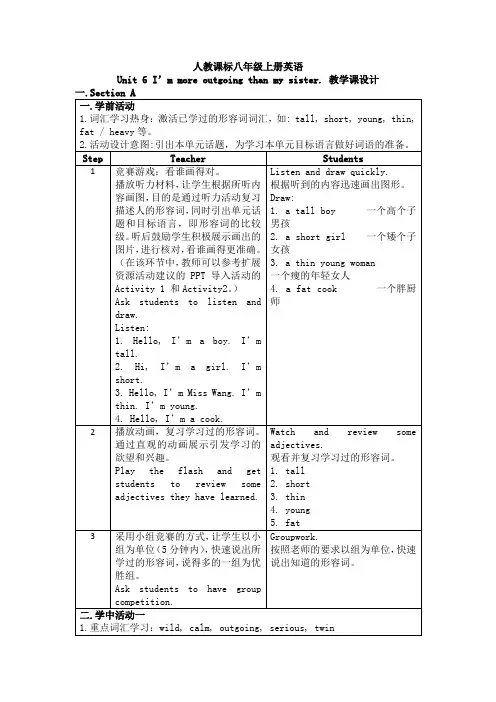
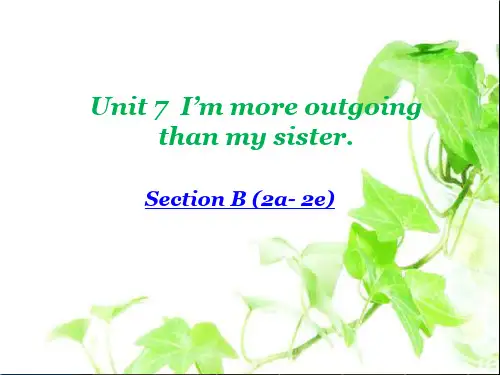
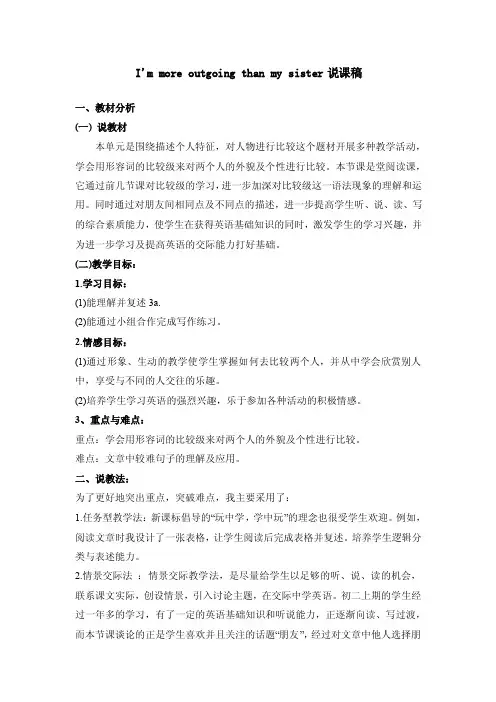
I'm more outgoing than my sister说课稿一、教材分析(一) 说教材本单元是围绕描述个人特征,对人物进行比较这个题材开展多种教学活动,学会用形容词的比较级来对两个人的外貌及个性进行比较。
本节课是堂阅读课,它通过前几节课对比较级的学习,进一步加深对比较级这一语法现象的理解和运用。
同时通过对朋友间相同点及不同点的描述,进一步提高学生听、说、读、写的综合素质能力,使学生在获得英语基础知识的同时,激发学生的学习兴趣,并为进一步学习及提高英语的交际能力打好基础。
(二)教学目标:1.学习目标:(1)能理解并复述3a.(2)能通过小组合作完成写作练习。
2.情感目标:(1)通过形象、生动的教学使学生掌握如何去比较两个人,并从中学会欣赏别人中,享受与不同的人交往的乐趣。
(2)培养学生学习英语的强烈兴趣,乐于参加各种活动的积极情感。
3、重点与难点:重点:学会用形容词的比较级来对两个人的外貌及个性进行比较。
难点:文章中较难句子的理解及应用。
二、说教法:为了更好地突出重点,突破难点,我主要采用了:1.任务型教学法:新课标倡导的“玩中学,学中玩”的理念也很受学生欢迎。
例如,阅读文章时我设计了一张表格,让学生阅读后完成表格并复述。
培养学生逻辑分类与表述能力。
2.情景交际法:情景交际教学法,是尽量给学生以足够的听、说、读的机会,联系课文实际,创设情景,引入讨论主题,在交际中学英语。
初二上期的学生经过一年多的学习,有了一定的英语基础知识和听说能力,正逐渐向读、写过渡,而本节课谈论的正是学生喜欢并且关注的话题“朋友”,经过对文章中他人选择朋友标准的学习,再调动学生自己的主观能动性,经过思考再写出自己对朋友的认识。
不仅进一步对语言学习进行了巩固,并在学习中融入了生活实践。
3.小组竞赛法:根据初中生争强好胜的性格特征,以及学生们对英语学习还保持着较浓厚的兴趣,所以进行竞赛环节,这样能很好的激发学生兴趣,给学生创造外语语言氛围,并培养学生集体荣誉感。
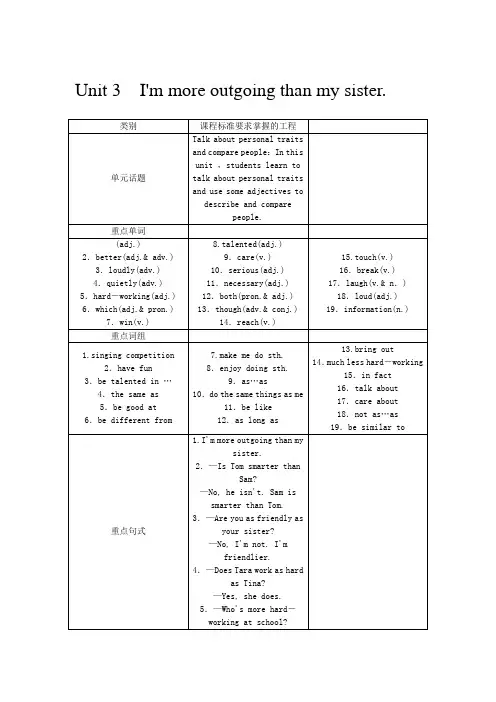
Unit 3I'm more outgoing than my sister.第一课时Section A (1a~1c)教学设计§自主学习案根据句意及首字母提示完成句子。
1.Peter plays the piano well, but Sam plays b etter than him.2.The bag is too h eavy. I can't carry it.3.B oth of the two classes did very well in this football game.4.Be q uiet,_please! The baby is sleeping.5.Jim is an o utgoing boy. He always says “hello〞 to us.§课堂导学案Step 1准备与热身(Preparation)Invite two Ss to stand in front of the classroom, and ask: Which student is taller, S1 or S2?Ss: S1.T: Yes, we can say like this: S1 is taller than S2. S2 is shorter than S1.Today we'll learn how to compare students or subjects.Step 2呈现与输入(Presentation)Look at the picture on page 17 in your book.What can you see in the picture?That's right,the twins. Look at these two boys. They are Peter and Paul.They are brothers.Who is taller,Peter or Paul?Yes,Peter is taller.Now repeat after me:Peter is taller .OK, please look at the blackboard and read these sentences.Please pay more attention to “…er…than…〞.This structure is used in comparisons. Now look at the words in the box in your book and match each word with the opposite. Please draw lines between the words of the opposite meanings. Now let's check the answers.Answers:tall—short,long hair—short hair,thin—heavy, quietly—loudly.Step 3练习与体验(Practice)Look at the picture again. The people in the picture are all twins. Twins are children born at the same time to the same parents.Sometimes they look exactly alike, but not always. The twins in this picture do not look exactly alike. Please listen to these three conversations and number the twins.You write the number 1 to 3 in the blanks beside the twins.OK,now,let's check the answers.Answers:Sam and Tom :1Tara and Tina :2Peter and Paul :3Step 4运用与生成(Production)Now practice the conversation in the picture. And then make your own conversation about the twins with your partner.I'll ask some pairs to present your conversations to the class.Step 5稳固与提高(Progress)【探究点】Sam has longer hair than Tom.Sam的头发比Tom的长。
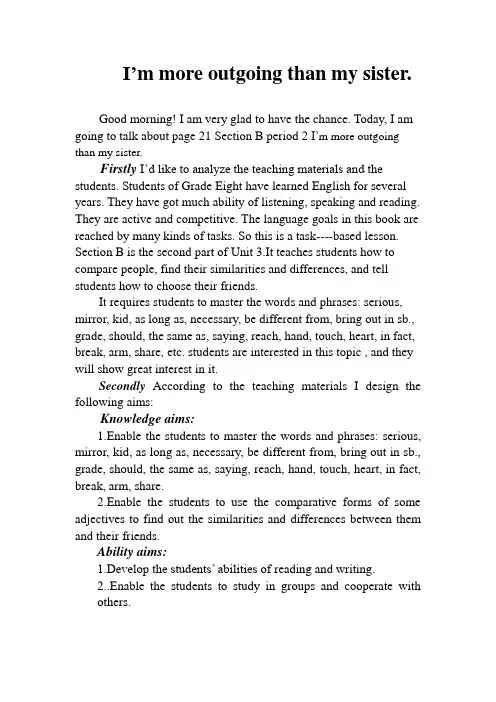
I’m more outgoing than my sister.Good morning! I am very glad to have the chance. Today, I am going to talk about page 21 Section B period 2 I’m more outgoing than my sister.Firstly I’d like to analyze the teaching materials and the students. Students of Grade Eight have learned English for several years. They have got much ability of listening, speaking and reading. They are active and competitive. The language goals in this book are reached by many kinds of tasks. So this is a task----based lesson. Section B is the second part of Unit 3.It teaches students how to compare people, find their similarities and differences, and tell students how to choose their friends.It requires students to master the words and phrases: serious, mirror, kid, as long as, necessary, be different from, bring out in sb., grade, should, the same as, saying, reach, hand, touch, heart, in fact, break, arm, share, etc. students are interested in this topic , and they will show great interest in it.Secondly According to the teaching materials I design the following aims:Knowledge aims:1.Enable the students to master the words and phrases: serious, mirror, kid, as long as, necessary, be different from, bring out in sb., grade, should, the same as, saying, reach, hand, touch, heart, in fact, break, arm, share.2.Enable the students to use the comparative forms of some adjectives to find out the similarities and differences between them and their friends.Ability aims:1.Develop the students’ abilities of reading and writing.2..Enable the students to study in groups and cooperate withothers.Emotion aims1 Inspire the students to cooperate and enhance their consciousness of competition.2 Motivate the students to study and help them form good learning habit as well.3 Make the students how to choose friends: a friend in need is a friend indeed.Thirdly I’d like to analyze my teaching and learning methods: first, I will chant with them to get the students revise the comparative forms of some adjectives and give students a brainstorm. And show them 3 different kinds of friends, then I will give them many different kinds of tasks. In this lesson I mainly used the task----based teaching approach.I will ask them to write about their friends without telling others names, get others guess who he/she is.At last , I get them to enjoy a poem about friend, it shows my emotion aims.Properties The CAI will be used.Assessment When they have both group and individual competition, I’ll praise students from time to time so as to give them encouragement. In this way, we can help students keep high enthusiasm.Fourthly I will discuss with you how I deal with the teaching process and its aims:Teaching process:Step 1 pre-readingTask 1 Warming--upChatting with the students twice with rhythm., and get them revise the comparative forms of some adjectives.The purpose is to create a relaxing atmosphere in order to help them concentrate in this class. As well as help them review at the same time. Help them get good preparation for the new content.Task 2 RevisionAsk students to do activity 2a, write the comparative forms of the adjectives and read them together. Then use them to write five sentences about them and their friends.As we know, this task will input some information to them. And make a good preparation for the new contents.Task 3 PresentationShow students two pictures ,one is a picture of my friends and me, the other is a tennis racket and a tennis ball. I give them a presentation of the usage of some new words and phrases in this lesson.The purpose of this step is getting students take great interest in it and learn about some new words.Step 2 While- readingShow students a chart, tell them to read the first passage and fill in the chart. And then according to some key information to retell their ideas about making friends, the similarities and differences between them and their friends.First , ask one to retell, then get all the students to repeat it once again.Step 3 Guessing game (Group work)In several groups, I will ask them to write about one of their group members on a piece of paper, they can following the model passages in 2b,and then they read it aloud together, and get others guess who he/she is.This is a report of their learning. In this step , students can practice writing compositions.Step 4 Enjoy a poemI will show them a English poem about friends, get them fill in the blanks and read it together.The purpose of this step is teaching students friend is very important in their life, let them be kind to their friends. FeedbackBy the chanting, task----based teaching approach, retellingpassages and guessing game etc. I have reached all the aims. The students have solid foundation and they like learning English very much. The most important is that, they are very interested in my class, because they are competitive and active. And the atmosphere is high. I think my class is very successful.。
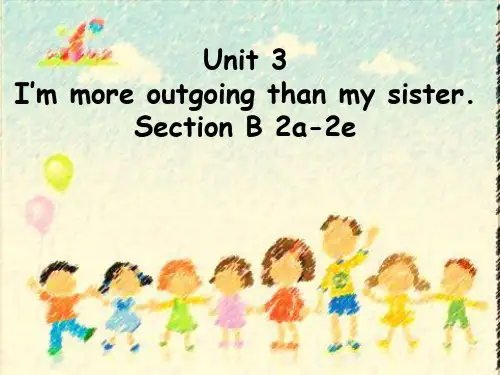
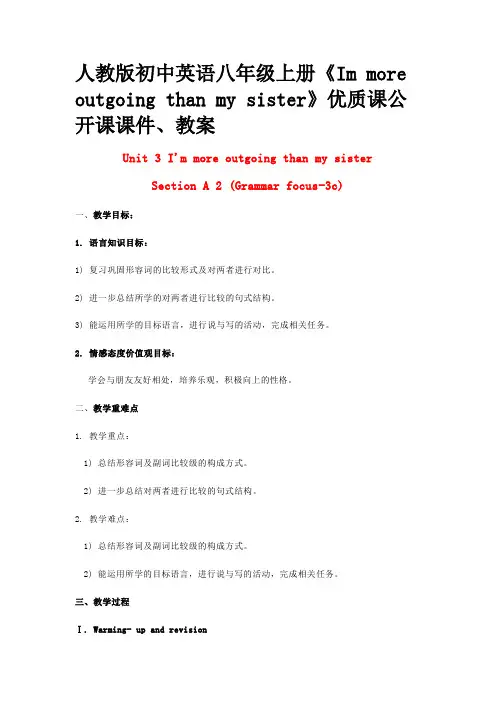
人教版初中英语八年级上册《Im more outgoing than my sister》优质课公开课课件、教案Unit 3 I'm more outgoing than my sisterSection A 2 (Grammar focus-3c)一、教学目标:1. 语言知识目标:1) 复习巩固形容词的比较形式及对两者进行对比。
2) 进一步总结所学的对两者进行比较的句式结构。
3) 能运用所学的目标语言,进行说与写的活动,完成相关任务。
2. 情感态度价值观目标:学会与朋友友好相处,培养乐观,积极向上的性格。
二、教学重难点1. 教学重点:1) 总结形容词及副词比较级的构成方式。
2) 进一步总结对两者进行比较的句式结构。
2. 教学难点:1) 总结形容词及副词比较级的构成方式。
2) 能运用所学的目标语言,进行说与写的活动,完成相关任务。
三、教学过程Ⅰ. Warming- up and revision1. Ask some Ss compare he/she with his/her desk mates.I’m taller than my desk mate. But she runs faster than me.…2. Show some pictures on the big screen. Let some Ss compare the things.3. Show some adjectives or adverbs. Let Ss add -er, -r or -ier to them.Ⅱ. Grammar Focus1. 学生阅读Grammar Focus中的句子,然后做填空练习。
(1) 汤姆比萨姆更聪明吗?Is Tom _______ _____ Sam?(2) 不是。
萨姆比汤姆更聪明。
No, he isn’t. Sam is ______ _____ Tom.(3) 塔拉比蒂娜更外向吗?Is Tara ____ ________ ______ Tina?(4) 不是。
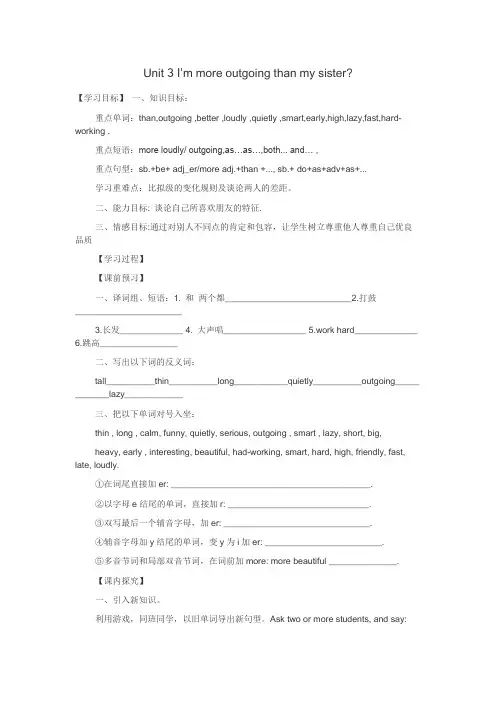
Unit 3 I’m more outgoing than my sister?【学习目标】一、知识目标:重点单词:than,outgoing ,better ,loudly ,quietly ,smart,early,high,lazy,fast,hard-working .重点短语:more loudly/ outgoing,as…as…,both... and… ,重点句型:sb.+be+ adj_er/more adj.+than +..., sb.+ do+as+adv+as+...学习重难点:比拟级的变化规则及谈论两人的差距。
二、能力目标: 谈论自己所喜欢朋友的特征.三、情感目标:通过对别人不同点的肯定和包容,让学生树立尊重他人尊重自己优良品质【学习过程】【课前预习】一、译词组、短语:1. 和两个都__________________________2.打鼓______________________3.长发_____________4. 大声唱_________________5.work hard_____________6.跳高________________二、写出以下词的反义词:tall__________thin__________long___________quietly__________outgoing_____ _______lazy____________三、把以下单词对号入坐:thin , long , calm, funny, quietly, serious, outgoing , smart , lazy, short, big,heavy, early , interesting, beautiful, had-working, smart, hard, high, friendly, fast, late, loudly.①在词尾直接加er: _________________________________________.②以字母e结尾的单词,直接加r: _____________________________.③双写最后一个辅音字母,加er: ______________________________.④辅音字母加y结尾的单词,变y为i加er: ________________________.⑤多音节词和局部双音节词,在词前加more: more beautiful ______________.【课内探究】一、引入新知识。
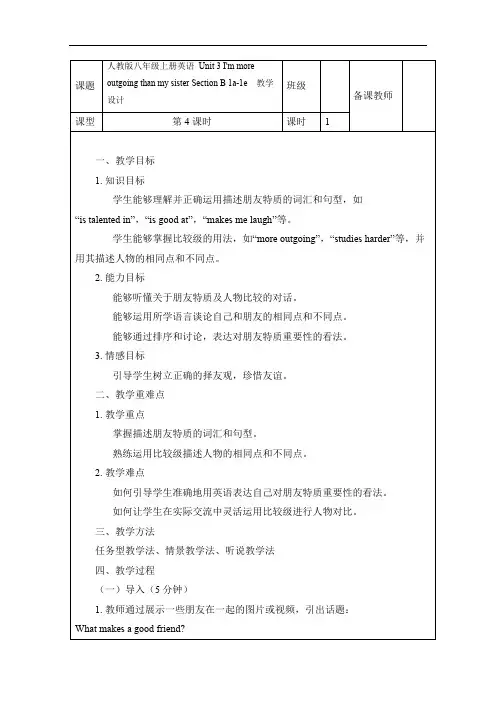
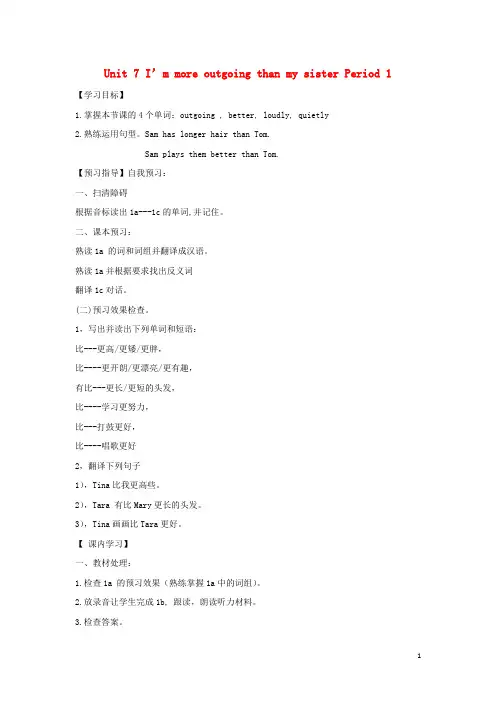
Unit 7 I’m more outgoing than my sister Period 1 【学习目标】1.掌握本节课的4个单词:outgoing , better, loudly, quietly2.熟练运用句型。
Sam has longer hair than Tom.Sam plays them better than Tom.【预习指导】自我预习:一、扫清障碍根据音标读出1a---1c的单词,并记住。
二、课本预习:熟读1a 的词和词组并翻译成汉语。
熟读1a并根据要求找出反义词翻译1c对话。
(二)预习效果检查。
1,写出并读出下列单词和短语:比---更高/更矮/更胖,比----更开朗/更漂亮/更有趣,有比---更长/更短的头发,比----学习更努力,比---打鼓更好,比----唱歌更好2,翻译下列句子1),Tina比我更高些。
2),Tara 有比Mary更长的头发。
3),Tina画画比Tara更好。
【课内学习】一、教材处理:1.检查1a 的预习效果(熟练掌握1a中的词组)。
2.放录音让学生完成1b, 跟读,朗读听力材料。
3.检查答案。
4.检查3c对话情况。
学生背诵此对话,然后结合1a图画两人一组自编对话。
5,展示成果,小组对话表演。
二、组内探讨:1,英语中的形容词有一般有几种形式?2, 怎样表示“比----更------”三,要点总结1, 英语形容词变比较级的一般方法1.规则变化单音节词和少数双音节词,加词尾-er,-est来构成比较级和最高级。
特殊变化:注:副词与形容词的变化方式相同课堂练习:一,单项选择( ) 1, This pencil is___ than that one.A. longestB. longC. longerD. as long( ) 2, These children are ____ this year than they were last year.A. more tallB. more tallerC. very tallerD. much taller( ) 3, It was very hot yesterday, but it is___ today.A. even hotterB. more hotterC. much more hotD. much hot( ) 4, Which do you like ___, tea or coffee?A. wellB. betterC. bestD. most( ) 5, This work is ____ for me than for you.A. difficultB. most difficultC. much difficultD. more difficult( )6,Which do you think tastes ____, the chicken or the fish?A. goodB. betterC. bestD. well二.根据中英文提示完成下列各句.1. 我弟弟很胖。
Unit 7 I’m more outgoing than my sister.Section A 1 (1a-2d)一、教学目标:1. 语言知识目标:1) 能掌握以下单词:outgoing, better, loudly, quietly, hard-working, competition, fantastic, which, clearly, win能掌握以下句型:①Tina is taller than Tara.②Sam has longer hair than Tom.③She also sings more loudly than Tara.2) 能掌握以下语法:①形容词或副词比较级形式的构成。
②表示两者进行比较的句式结构。
2. 情感态度价值观目标:能对人物的外表进行描绘,个性进行比较。
二、教学重难点1. 教学重点:1) 形容词或副词比较级形式的构成。
2) 表示两者进行比较的句式结构。
2. 教学难点:He has shorter hair than Sam.Is Tom smarter than Tim?She also sings more loudly than Tara.三、教学过程Ⅰ. Lead-in1. Ask Ss to write down as many adj. about people as possible. Check the adj. Ss write and we can group them into some pairs, like: [Section A 1a]tall --- short; thin --- heavy, long hair --- short hair, calm --- wild …Give Ss an example by comparing Old Henry and Santa Claus.e.g. Santa Claus is older than Henry. Henry is taller than Santa Claus.Henry is younger than Santa Claus. Santa Claus is younger than Henry.Ⅱ. PresentationAsk Ss to see the pix about apples and pears to see the differences. Then compare some of their things with each other.e.g. The apples are bigger than the pears.The pears are more delicious than the apples.Summarize the Comparatives. Group competition.A + be(V) + 比较级+ than + B.Ⅲ. Game (I and my desk mate)Ask Ss to compare with their partners and find out the differences.e.g. She is heavier than me. I am more outgoing than her.She gets up earlier than me. I run faster than her.Ⅳ. ListeningThen listen to the recording. Ask Ss to number the twins.Check the answers.Ⅴ. Pair workPoint out the sample conversation in activity 1c.Say, now work with a partner. Make your own conversation about the twins.Ask several pairs to say one or more of their conversations.Ⅵ. Listening1. Work on 2a:Point out the two columns and read the headings: -er, -ier and more. Then point out the words in the box. Read them.Say, now listen and write the –er and –ier words in the first column and the words that use more in the second column.Play the recording and check the answers.2. Work on 2b.Point out the picture and the two boxes with the headings Tina is and Tara is.Say, listen to the recording. Write word in the boxes. The words are from the list in activity 2a.Play the recording and check the answers.Ⅶ. Pair work1. Point out the chart in activity 2c. Say, Make your own conversations according to the information. Ask pairs to continue on their own.2. Ss practice their conversations.3. Ask some pairs to act out their conversations.Ⅷ. Role-play1. Read the conversation first and try to match the people with the right things.a.sang betterb.with shorter hairc.practice more and really wanted to wind.sang more clearlye.danced better2. Let Ss read the conversations after the teacher.3. Let Ss practice the conversation.4. Then let some pairs act out their conversations in front of the class.Homework:Write six sentences:Write about the things that are the same and different between you and your best friend.板书设计:Section A 2 (Grammar focus-3c)一、教学目标:1. 语言知识目标:1) 复习巩固形容词的比较形式及对两者进行对比。
2) 进一步总结所学的对两者进行比较的句式结构。
3) 能运用所学的目标语言,进行说与写的活动,完成相关任务。
2. 情感态度价值观目标:学会与朋友友好相处,培养乐观,积极向上的性格。
二、教学重难点1. 教学重点:1) 总结形容词及副词比较级的构成方式。
2) 进一步总结对两者进行比较的句式结构。
2. 教学难点:1) 总结形容词及副词比较级的构成方式。
2) 能运用所学的目标语言,进行说与写的活动,完成相关任务。
三、教学过程Ⅰ. Warming- up and revision1. Ask some Ss compare he/she with his/her desk mates.I’m taller than my desk mate. But she runs faster than me.…2. Show some pictures on the big screen. Let some Ss compare the things.3. Show some adjectives or adverbs. Let Ss add -er, -r or -ier to them. Ⅱ. Grammar Focus1. 学生阅读Grammar Focus中的句子,然后做填空练习。
(1) 汤姆比萨姆更聪明吗?Is Tom _______ _____ Sam?(2) 不是。
萨姆比汤姆更聪明。
No, he isn’t. Sam is ______ _____ Tom.(3) 塔拉比蒂娜更外向吗?Is Tara ____ ________ ______ Tina?(4) 不是。
蒂娜比塔拉更外向。
No, she isn’t. Tina is ______ ________ ___ Tara.(5) 你和你姐姐一样友善吗?_____ you _____ friendly _____ your sister?(6) 不是。
我更友善一些。
No, I’m not. I’m ___________.(7) 塔拉与蒂娜工作一样努力吗?Does Tara work _____ ______ _____ Tina?(8) 谁在学校里更努力一些?Who’s ______ _____________ at school?(9) 蒂娜认为她学习比我更努力。
Tina thinks she ______ _______ than me.3. 学生们完成填空试题后,可以打开课本检查答案,对错误的句子,单独进行强化记忆。
Ⅲ. Try to Find总结:两者进行比较, 表示“一方比另一方更……”的句型:1. A + be + 形容词比较级+ than + B2. A + 实义动词+ 副词比较级+ than + B两者进行比较, 表示“一方与另一方一样……”的句型:1. A + be + as 形容词原形+ as + B2. A + 实义动词+ as 副词原形+ as + BⅣ. PracticeWork on 3a:1. 读下列句子,根据提示词完成一般疑问句,并做回答。
2. 看所给的第一例句,让一名学生读例句,确定所有的学生都明白本题的做法。
方法指导:应通读所给的提示词,掌握句子大意;然后,确定进行对比的双方及所给的形容词,根据上一环节中所总结的句式结构来组成正确的一般疑问句。